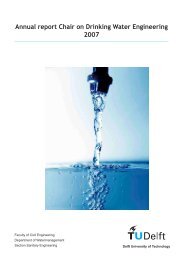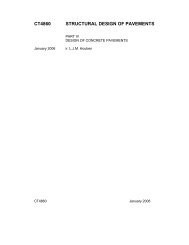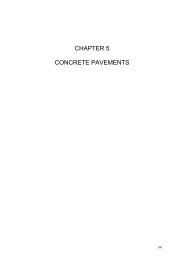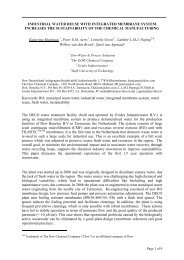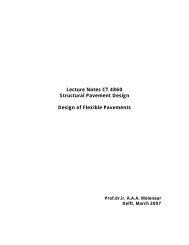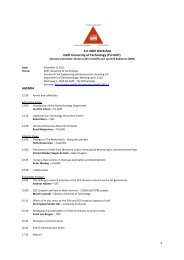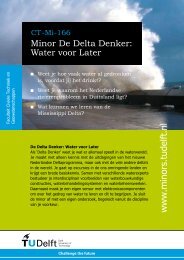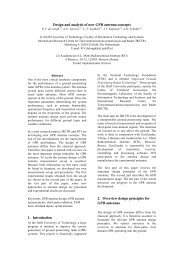Annual report Chair on Drinking Water Engineering 2008 - TU Delft
Annual report Chair on Drinking Water Engineering 2008 - TU Delft
Annual report Chair on Drinking Water Engineering 2008 - TU Delft
Create successful ePaper yourself
Turn your PDF publications into a flip-book with our unique Google optimized e-Paper software.
Research projects:<br />
Removal of trace organic pollutants by membrane filtrati<strong>on</strong> in water reuse applicati<strong>on</strong>s Arne Verliefde<br />
AOP and artificial recharge and recovery: a synergistic hybrid for micro pollutants Karin Teunissen<br />
QSARs in drinking water treatment David de Ridder<br />
Degradati<strong>on</strong> products in drinking water due to oxidative water treatment processes Zahira Herrera Rivera<br />
Microbial degradati<strong>on</strong> of micro pollutants in drinking water Marco Casola<br />
Multiple water reuse: sustainable design without precipitati<strong>on</strong> based <strong>on</strong> a new P-index Lamber Paping<br />
Theme 3: Modeling, sensoring and automati<strong>on</strong><br />
Theme leader: Luuk Rietveld<br />
<strong>Drinking</strong> water treatment plants c<strong>on</strong>sists of numerous treatment processes in series and in parallel. The operati<strong>on</strong><br />
of the present-day infrastructure is d<strong>on</strong>e by operators that mainly focus <strong>on</strong> providing the required flow at all times.<br />
It is obvious that it is possible to achieve better results at lower costs and with less impact <strong>on</strong> the envir<strong>on</strong>ment by<br />
utilising available opti<strong>on</strong>s such as buffer tanks, equal flow distributi<strong>on</strong> over filters, flow c<strong>on</strong>trol and process c<strong>on</strong>trol.<br />
By using computer models it is now also possible to improve the water quality leaving the treatment plant while<br />
delivering the required flow. Focus of this theme is <strong>on</strong> an optimised process and flow c<strong>on</strong>trol by mass balance<br />
based modeling and by more sophisticated computati<strong>on</strong>al fluid dynamics. Also stochastic data models are used<br />
to assess the efficiency of treatment processes. We aim to achieve the c<strong>on</strong>cept of a ‘virtual treatment plant’, that<br />
is a model of the plant that can functi<strong>on</strong> as a simulator to assist the operator in finding the optimal settings.<br />
Research projects:<br />
Developing and modeling of oxidati<strong>on</strong> processes for water treatment Alex van der Helm<br />
Modeling of biological activated carb<strong>on</strong> filtrati<strong>on</strong> René van der Aa<br />
Simulati<strong>on</strong> of drinking water treatment plants Ignaz Worm<br />
Grey-box modeling and plant-wide integrated c<strong>on</strong>trol of water purificati<strong>on</strong> processes Kim van Schagen<br />
CFD in drinking water treatment Bas Wols<br />
Microbial risk analysis framework Patrick Smeets<br />
Modeling and m<strong>on</strong>itoring of drinking water treatment processes Petra Ross<br />
Integrated modeling of c<strong>on</strong>venti<strong>on</strong>al drinking water treatment Javier Sanchez<br />
12 <str<strong>on</strong>g>Annual</str<strong>on</strong>g> <str<strong>on</strong>g>report</str<strong>on</strong>g> DWE <strong>2008</strong>



